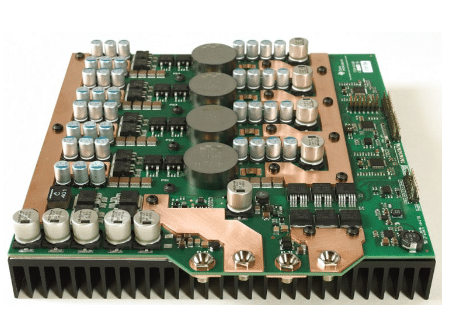It offers a scalable multiphase option and utilises a highly integrated solution with automotive-qualified components, ensuring robust performance and reliability in automotive applications.

A bidirectional DC-DC converter is pivotal in inefficient electrical energy transfer and storage applications. Such systems typically incorporate two batteries, a battery with a motor generator, or a combination of both. The optimal performance is achieved using Lithium-Ion (Li-Ion) or Lithium-Polymer (Li-Pol) technologies, although lead-acid (Pb) batteries are also employed for their high capacity and cost-efficiency.
The TIDA-01168 reference design by Texas Instruments serves as a four-phase, bidirectional DC-DC converter development platform for 12-V/48-V automotive systems. It leverages two LM5170-Q1 current controllers alongside a TMS320F28027F microcontroller (MCU) to manage the power stage control. The LM5170-Q1 subsystems use average current feedback for current control, while the C2000™ microcontroller handles voltage feedback, thereby eliminating the need for phase current balancing common in multiphase converters. This setup allows for a high level of integration, reducing the printed-circuit board (PCB) area, simplifying the design, and speeding up development. It supports a 12V input voltage range of 6V to 18V and a 48V input voltage range of 24V to 54V. The design includes comprehensive protection mechanisms against reverse polarity, overcurrent, overvoltage, and overtemperature.
Applications for this design include in-vehicle power distribution in 12-V/48-V automotive systems and supercapacitor or battery backup power converters. The LM5170-Q1 controller is integral, providing high voltage and precision elements for dual-channel bidirectional converters in automotive dual battery systems. Supporting components include the LM5010Ax step-down switching regulator with an extended input range, and the TPS560200-Q1, a 17-V, 500-mA low-IQ buck converter with integrated MOSFETs. The TMP102-Q1 digital temperature sensor is ideal for high-accuracy applications, and the TPS3306 family of supervisory circuits is designed for monitoring dual supply voltages in DSP and processor-based systems.
It employs a non-isolated synchronous step-down converter topology, where synchronous switches facilitate bidirectional current flow in boost mode. The converter appears as a synchronous step-down from the 48-V side and as a synchronous step-up from the 12-V side. This multiphase DC-DC converter, based on four buck power stages operating in parallel, offers benefits like lower output ripple, faster transient response, smaller inductor size, and even power dissipation distribution over the board. The LM5170-Q1 controllers manage all four power stages, providing comprehensive control, including gate drivers and current sensing, without a voltage feedback loop. Each side of the converter features a circuit breaker controlled by back-to-back N-MOSFETs. The LM5170-Q1 handles the 12-V side, protecting against reverse polarity and ensuring low standby current, while the LM5060-Q1 controls the 48-V side, safeguarding against Undervoltage, overvoltage, and overcurrent events.
TI has tested this reference design. It comes with a bill of materials (BOM), schematics, assembly drawing, printed circuit board (PCB) layout, etc. You can find additional data about the reference design on the company’s website. To read more about this reference design, click here.






